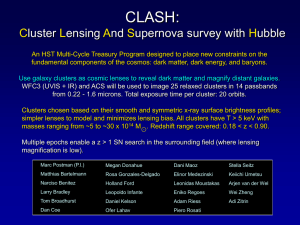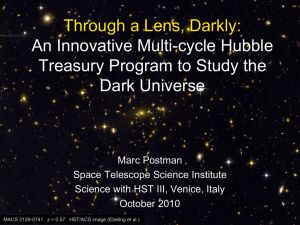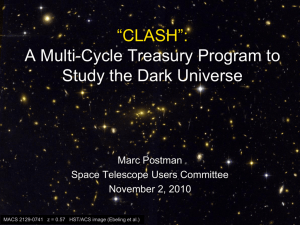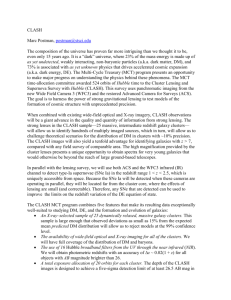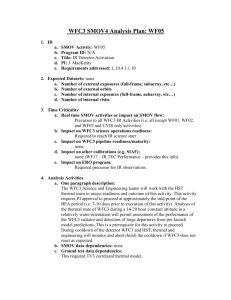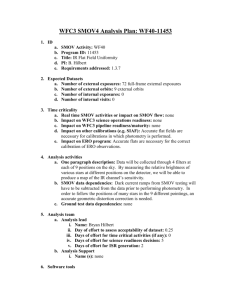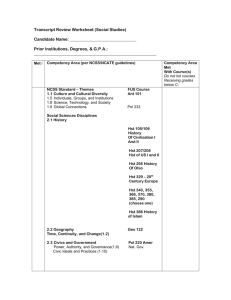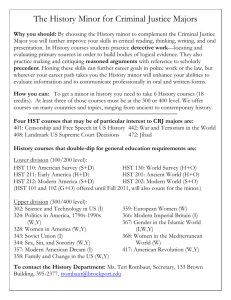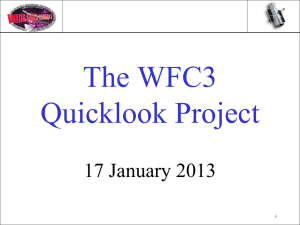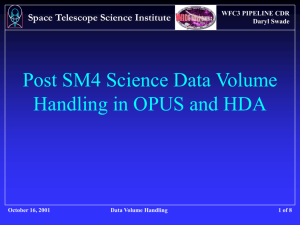mpostman_HSTIII_Oct2..
advertisement
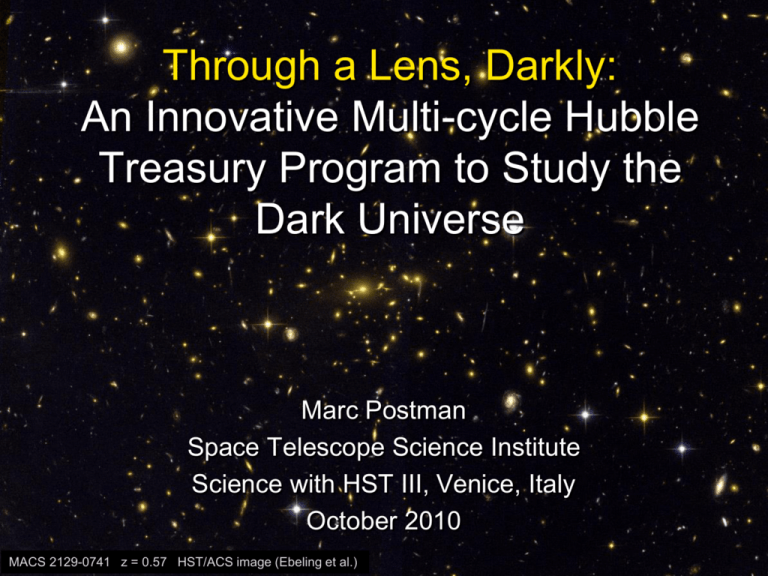
Through a Lens, Darkly: An Innovative Multi-cycle Hubble Treasury Program to Study the Dark Universe Marc Postman Space Telescope Science Institute Science with HST III, Venice, Italy October 2010 MACS 2129-0741 z = 0.57 HST/ACS image (Ebeling et al.) CLASH: Cluster Lensing And Supernova survey with Hubble An HST Multi-Cycle Treasury Program designed to place new constraints on the fundamental components of the cosmos: dark matter, dark energy, and baryons. CL0024 A1689 A2218 MS1358 A1703 To accomplish this, we will use galaxy clusters as cosmic lenses to reveal dark matter and magnify distant galaxies. Multiple observation epochs enable a z > 1 SN search in the surrounding field (where lensing magnification is low). This allows us to improve the constraints on both the time dependence of the dark energy equation of state and on the amplitude of systematic errors in cosmological parameters. The CLASH Science Team: Marc Postman, P.I. Matthias Bartelmann Narciso “Txitxo” Benitez Rychard Bouwens Larry Bradley Thomas Broadhurst Dan Coe Megan Donahue Rosa González-Delgado Holland Ford, co-P.I. Genevieve Graves Øle Host Leopoldo Infante Stéphanie Jouvel Daniel Kelson Ofer Lahav Ruth Lazkoz Doron Lemze Dan Maoz Elinor Medezinski Peter Melchior Massimo Meneghetti Julian Merten Leonidas Moustakas Enikö Regös Adam Riess Piero Rosati Stella Seitz Keiichi Umetsu Arjen van der Wel Wei Zheng Adi Zitrin Space Telescope Science Institute (STScI) Universität Heidelberg Instituto de Astrofisica de Andalucia (IAA) Leiden University STScI University of the Basque Country Jet Propulsion Laboratory (JPL) / Caltech Michigan State University IAA The Johns Hopkins University (JHU) University of California, Berkeley University College London (UCL) Universidad Católica de Chile UCL Carnegie Institute of Washington UCL University of the Basque Country JHU Tel Aviv University (TAU) JHU Universität Heidelberg INAF / Osservatorio Astronomico di Bologna Universität Heidelberg JPL/Caltech European Laboratory for Particle Physics (CERN) STScI / JHU European Southern Observatory Universitas Sternwarte München Academia Sinica, Institute of Astronomy & Astrophysics Max Planck Institüt für Astronomie JHU TAU Post-doctoral fellow Graduate student Fundamental Questions That Remain Unanswered or Unverified 130 Mpc • How is dark matter distributed in cluster & massive galaxy halos? – How centrally concentrated is the DM? Implications for epoch of 12.5 Gyr formation. – What degree of substructure exists? And on what scales? – How does the DM distribution evolve with time? – What is the characteristic shape of a typical cluster DM halo? “Millennium” simulation of DM Springel et al. 2005 Fundamental Questions That Remain Unanswered or Unverified • When was the epoch of first galaxy formation? – What are the characteristics (mass, “metal” abundance, star formation rates, global structure) of the most distant galaxies in the universe (tU < 800 Myr)? – What was their role in ionizing the intergalactic medium? Young galaxies (z ~ 7) Oesch et al. 2010 Fundamental Questions That Remain Unanswered or Unverified • Why is the expansion of the universe accelerating? w = P / ρc2 w = -1 (cosmo constant) – Is it something other than Λ? – What are the parameters of the w ≠ constant; scalar field e.g. Quintessence, k-essence dark energy equation of state? – What is the time derivative of the equation of state? w – How standard are our “standard” 1+z candles (cosmic distance indicators)? Need better Is w a f(z)? measurements of systematic w(z) = wo + wa z/(1+z) effects at large lookback times. (e.g., Linder 2003) Abell 209 MACS 0329-0211 RXJ 0647+7015 Abell 383 core MACS 0717+3745 RXJ 1347-1145 Abell 611 Abell 963 Abell 2261 CLJ1226+3332 MACS 0744+3927 MACS 1115+0129 MACS 1149+2223 MACS 1206-0847 RXJ 1423+2404 MS-2137 core RXJ 1720+3536 RXJ 2129+0005 All clusters have Tx > 5 keV z_med ~ 0.4 Cutouts of x-ray images of 23 of the 25 CLASH clusters from Chandra Observatory MACS 0429-0253 MACS 1311-0310 RXJ 1532+3020 MACS 1931-2634 RXJ 2248-4431 Cluster Sample Size Justification Observational Want to measure mean “concentration” of DM profile to ~10% accuracy: NCL ≈ ( σtot / f )2 f = 0.10 σtot2 = σLSS2 + σint2 + σMeas2 σLSS = 0.13 (e.g., Hoekstra et al. 2003) σint = 0.30 (e.g., Neto et al. 2007) σMeas = 0.22 ( Narc, CL0024 / Narc)½ (Umetsu et al. 2010) NCL = 24 Theoretical N-body simulations show DM profile concentration distns are log-normal with σ~ 0.25±0.03 (e.g., Jing 2000; Meneghetti et al. 2009). Ratio needed to reject hypothesis that observed DM concentrations follow the LCDM predictions at 99% C.L. given a sample with the indicated # clusters. Comprehensive Multi-wavelength Coverage HST 524 orbits: 25 clusters, each imaged in 16 passbands. (0.23 – 1.6 μm) ~20 orbits per cluster. Chandra x-ray Observatory archival data (0.5 – 7 keV) Spitzer IR Space Telescope archival data (3.6, 4.5 μm) SZE observations (Bolocam, Mustang) to augment existing data (sub-mm) Subaru wide-field imaging (0.4 – 0.9 μm) VLT, Magellan Spectroscopy CLASH: An HST Multi-Cycle Treasury Program WFC3 Parallels Cluster Pointings ACS Parallels 6 arcmin. = 2.2 Mpc @ z=0.5 SN search cadence: 10d-14d, 4 epochs per orient Footprints of HST Cameras: ACS FOV in yellow, WFC3/IR FOV in red, WFC3/UVIS in blue. Footprint of our 2 ORIENT survey: The area of the complete 16-band coverage in the cluster center is 4.07 square arcminutes (88% of the WFC3/IR FOV). Lensing amplification small at these radii CLASH: An HST Multi-Cycle Treasury Program Deep HST image of massive cluster R Einstein NArcs R (6.5 Million Light Years) Simulation of dark matter around a forming cluster (Springel et al. 2005) WHERE IS THE RESULTING SPATIAL RESOLUTION OF THE DARK MATTER MAP CLASH: An HST Multi-Cycle Treasury Program Why 16 filters? F225W … 235.9 nm WFC3/UVIS F275W … 270.4 nm WFC3/UVIS F336W … 335.5 nm WFC3/UVIS F390W … 392.1 nm WFC3/UVIS Spectroscopic redshifts Photometric redshifts Mag distn of multiply lensed arcs in A1689 and CL0024 Arcs in A1689 and CL0024 F435W … 430.6 nm ACS/WFC F475W … 474.2 nm ACS/WFC F606W … 592.0 nm ACS/WFC F625W … 629.8 nm ACS/WFC F775W … 769.4 nm ACS/WFC F814W … 806.9 nm ACS/WFC F850LP … 906.0 nm ACS/WFC F105W … 1.055 μm WFC3/IR F110W … 1.152 μm WFC3/IR F125W … 1.248 μm WFC3/IR F140W … 1.392 μm WFC3/IR F160W … 1.536 μm WFC3/IR Will yield photometric redshifts with rms error of ~2% x (1 + z) for sources down to ~26 AB mag. Gravitational lensing analysis reveals dark matter substructure HST Image of Cluster Reconstructed Mass Surface Density Region of Reliable Reconstruction Abell 1689 2010 Coe et al. DM substructure resolution in this map is ~23 kpc. DM substructure resolution for typical CLASH cluster will be ~30 – 40 kpc. Structure Formation History and DM properties are encoded in DM Halo profiles and shapes Dark matter halos are predicted to have a roughly universal density profile (NFW / Sersic / Einasto) Density profile: flatter in core, steeper in outskirts Observed Concentration Simulated Abell 1689 Best fit to data shown here lensing bias The DM concentration is predicted to decline with increasing cluster mass because in the hierarchical model massive clusters collapse later, when the cosmological background density is lower. predicted Comerford & Natarajan 2007 Oguri et al. 2009 Both Strong & Weak Lensing Measurements Needed for Good Constraints Umetsu et al. 2010 LCDM prediction from Duffy et al. 2008 CLASH will: • Use 3 independent lensing constraints: SL, WL, mag bias • Have a well-selected cluster sample with minimal lensing bias • Definitively derive the representative equilibrium mass profile shape • Robustly measure cluster DM concentrations and their dispersion as a function of cluster mass (and possibly their redshift evolution). • Provide excellent calibration of mass-observable relations for clusters We expect to find tens of bright (m < 26.5 AB) z > 7 galaxies CLASH Survey Limit CLASH (predicted) Field survey with identical area Lensing greatly enhances the ability to detect distant galaxies and provides an additional constraint on their redshifts, as the projected position of the lensed object is a function of the source redshift. WFC3/IR z-band dropouts Bradley et al. 2010 (in prep): Abell 1703 435 nm 475 nm 555 nm ■ 1 625 orbit nm each in WFC3/IR F125W (J) and F160W (H) 775 nm 850 nm μ~3-5 Brightest candidate: z ~ 1.6 μm 6.9, H160 ~ 24.3 AB (brightest z ~ 7 candidate known) Can reliably constrain SED 1.25 μm Highly Magnified z ~ 5 galaxies Zitrin et al. 2010 z = 4.92 Galaxy ACS PSF ■ Reconstruction of a z = 4.92 source lensed by the z = 0.33 cluster MS1358+62. ■ Best resolved high-z object: spatial resolution of ~50 pc (rest-frame UV) 0.2” How object would look without cluster lensing ■ Equivalent to 20-m space telescope resolution of a non-lensed z=5 galaxy! HST: 23 SNe Ia at z>1 Find Past Deceleration, Confirms Dark Energy+Dark Matter Model G R O U N D S P A C E Riess et al. 2004, 2007 z>1 is a particularly important regime for testing “astrophysical contamination” of SN cosmology signal, such as dust or evolution. Also key for constraining HST & WFC3-IR, Gateway to SNe Ia at z>2 Δ mag (vs. wo = -1, wa = 0) Assuming a mixed SN delay time distn (~50% prompt, ~50% 2-3 Gyr): expect CLASH to find 10 – 20 SNe at z>1; and ~6 with z > 1.5, doubling the known number of z > 1 SN Dark Energy Dominated Dark Matter Dominated MCT MCT CURRENT HST LIFETIME Two MCT HST programs (CLASH + CANDELS) will detect SNe Ia at 1.0 < z < 2.5. They will provide a direct test of the SN systematics in a matter-dominated universe (e.g., Riess & Livio 2006). Concluding Comments CLASH observations with HST to begin in November. 25 clusters will be observed over the course of cycles 18-20 (~3 years): 10, 10, 5. Represents a major observational initiative to constrain the properties of DM, high-z galaxies, and advance our understanding of DE. Immediate public access to all HST data. High-level science products will be released on a regular schedule, including compilations of xray, IR, sub-mm, and spectroscopic data. http://www.stsci.edu/~postman/CLASH
